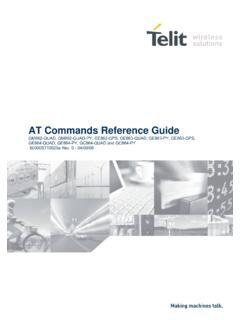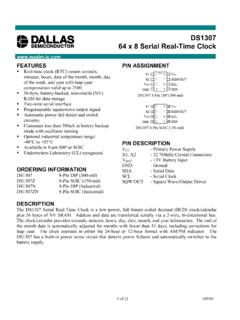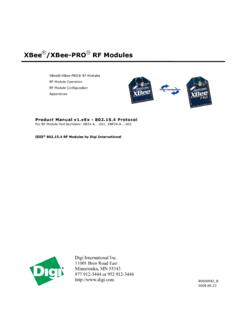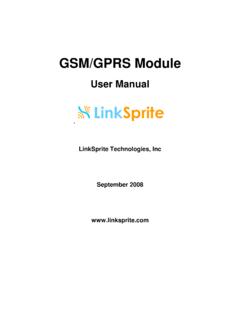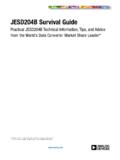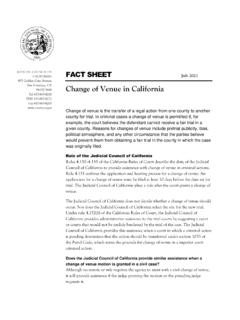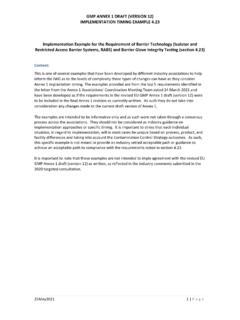Transcription of I2S bus specification - SparkFun Electronics
1 Philips SemiconductorsI2S bus specification1 February 1986 Revised: June 5, INTRODUCTIONMany digital audio systems are being introduced into the consumeraudio market, including compact disc, digital audio tape, digitalsound processors, and digital TV-sound. The digital audio signals inthese systems are being processed by a number of (V)LSI ICs,such as: A/D and D/A converters; digital signal processors; error correction for compact disc and digital recording; digital filters; digital input/output communication structures are vital for both theequipment and the IC manufacturer, because they increase systemflexibility. To this end, we have developed the inter-IC sound (I2S)bus a serial link especially for digital BASIC SERIAL BUS REQUIREMENTSThe bus has only to handle audio data, while the other signals, suchas sub-coding and control, are transferred separately. To minimizethe number of pins required and to keep wiring simple, a 3-line serialbus is used consisting of a line for two time-multiplexed datachannels, a word select line and a clock the transmitter and receiver have the same clock signal fordata transmission, the transmitter as the master, has to generate thebit clock, word-select signal and data.
2 In complex systems however,there may be several transmitters and receivers, which makes itdifficult to define the master. In such systems, there is usually asystem master controlling digital audio data-flow between thevarious ICs. Transmitters then, have to generate data under thecontrol of an external clock, and so act as a slave. Figure 1illustrates some simple system configurations and the basicinterface timing . Note that the system master can be combined witha transmitter or receiver, and it may be enabled or disabled undersoftware control or by pin SCKword select WSdata SDRECEIVERTRANSMITTER = MASTERTRANSMITTERSCKWSSDRECEIVERRECEIVER = MASTERTRANSMITTERSCKWSSDRECEIVERCONTROLL ER = MASTERCONTROLLERSCKWSSDWORD n 1 RIGHT CHANNELWORD n+1 RIGHT CHANNELWORD nLEFT CHANNELLSBMSBMSBSN00119 Figure 1. Simple System Configurations and Basic Interface TimingPhilips SemiconductorsI2S bus specificationFebruary THE I2S BUSAs shown in Figure 1, the bus has three lines: continuous serial clock (SCK); word select (WS); serial data (SD);and the device generating SCK and WS is the Serial DataSerial data is transmitted in two s complement with the MSB MSB is transmitted first because the transmitter and receivermay have different word lengths.
3 It isn t necessary for the transmitterto know how many bits the receiver can handle, nor does thereceiver need to know how many bits are being the system word length is greater than the transmitter wordlength, the word is truncated (least significant data bits are set to 0 )for data transmission. If the receiver is sent more bits than its wordlength, the bits after the LSB are ignored. On the other hand, if thereceiver is sent fewer bits than its word length, the missing bits areset to zero internally. And so, the MSB has a fixed position, whereasthe position of the LSB depends on the word length. The transmitteralways sends the MSB of the next word one clock period after theWS data sent by the transmitter may be synchronized with eitherthe trailing (HIGH-to-LOW) or the leading (LOW-to-HIGH) edge ofthe clock signal. However, the serial data must be latched into thereceiver on the leading edge of the serial clock signal, and so thereare some restrictions when transmitting data that is synchronizedwith the leading edge (see Figure 2 and Table 1).
4 Word SelectThe word select line indicates the channel being transmitted: WS = 0; channel 1 (left); WS = 1; channel 2 (right).WS may change either on a trailing or leading edge of the serialclock, but it doesn t need to be symmetrical. In the slave, this signalis latched on the leading edge of the clock signal. The WS linechanges one clock period before the MSB is transmitted. This allowsthe slave transmitter to derive synchronous timing of the serial datathat will be set up for transmission. Furthermore, it enables thereceiver to store the previous word and clear the input for the nextword (see Figure 1). TIMINGIn the I2S format, any device can act as the system master byproviding the necessary clock signals. A slave will usually derive itsinternal clock signal from an external clock input. This means, takinginto account the propagation delays between master clock and thedata and/or word-select signals, that the total delay is simply thesum of: the delay between the external (master) clock and the slave sinternal clock; and the delay between the internal clock and the data and/orword-select data and word-select inputs, the external to internal clock delayis of no consequence because it only lengthens the effective set-uptime (see Figure 2).
5 The major part of the time margin is toaccommodate the difference between the propagation delay of thetransmitter, and the time required to set up the timing requirements are specified relative to the clock period or tothe minimum allowed clock period of a device. This means thathigher data rates can be used in the *tLC = = 0tdtr = clock periodTtr= minimum allowed clock period for transmitterT>Ttr tRC is only relevant for transmitters in slave 2. timing for I2S TransmitterPhilips SemiconductorsI2S bus specificationFebruary 19863 SDandWSSCKTtLC = = = clock periodTr= minimum allowed clock period for transmitterT>Trtsr 0SN00121 Figure 3. timing for I2S ReceiverNote that the times given in both Figures 2 and 3 are defined by the transmitter speed. The specification of the receiver has to be able to matchthe performance of the transmitterExample: Master transmitter with data rate of ( 10%) (all values in ns)MINTYPMAXCONDITION clock period T360400440 Ttr = 360clock HIGH tHC160min > = 140 (at typical data rate)clock LOW tLC160min > = 140 (at typical data rate)delay tdtr300max < = 320 (at typical data rate)hold time thtr100min > 0clock rise-time tRC60max > = 54 (only relevant in slave mode)Example: Slave receiver with data rate of ( 10%) (all values in ns)MINTYPMAXCONDITION clock period T360400440 Ttr = 360clock HIGH tHC110min < = 126clock LOW tLC110min < = 126set-up time tsr60min < = 72hold time thtr0min < 0 Philips SemiconductorsI2S bus specificationFebruary 19864 Table 1.
6 timing for I2S transmitters and receiversTRANSMITTERRECEIVERLOWER LIMITUPPER LIMITLOWER LIMITUPPER LIMITMINMAXMINMAXMINMAXMINMAXNOTESC lock period TTtrTr1 MASTER MODE:clock generated by transmitter or receiver:HIGH MODE:clock accepted by transmitter or receiver:HIGH :delay time thtr03 RECEIVER:set-up time time thr05 All timing values are specified with respect to high and low threshold :1. The system clock period T must be greater than Ttr and Tr because both the transmitter and receiver have to be able to handle the datatransfer At all data rates in the master mode, the transmitter or receiver generates a clock signal with a fixed mark/space ratio. For this reason tHCand tLC are specified with respect to In the slave mode, the transmitter and receiver need a clock signal with minimum HIGH and LOW periods so that they can detect the long as the minimum periods are greater than , any clock that meets the requirements can be used (see Figure 3).
7 3. Because the delay (tdtr) and the maximum transmitter speed (defined by Ttr) are related, a fast transmitter driven by a slow clock edge canresult in tdtr not exceeding tRC which means thtr becomes zero or negative. Therefore, the transmitter has to guarantee that thtr is greaterthan or equal to zero, so long as the clock rise-time tRC is not more than tRCmax, where tRCmax is not less than To allow data to be clocked out on a falling edge, the delay is specified with respect to the rising edge of the clock signal and T, always givingthe receiver sufficient set-up The data set-up and hold time must not be less than the specified receiver set-up and hold RISINGCLOCK EDGEDATA thtrtdtrSN00122 Figure 4. Clock rise-time definition with respect to the voltage levelsPhilips SemiconductorsI2S bus specificationFebruary VOLTAGE LEVEL Output LevelsVL< > both levels able to drive one standard TTL input (IIL = and IIH = ).
8 Input LevelsVIL= : At present, TTL is considered a standard for logic levels. Asother IC (LSI) technologies become popular, other levels willalso be POSSIBLE HARDWARE Transmitter (see Figure 5)At each WS-level change, a pulse WSP is derived for synchronouslyparallel-loading the shift register. The output of one of the datalatches is then enabled depending on the WS signal. Since theserial data input is zero, all the bits after the LSB will also be Receiver (see Figure 6)Following the first WS-level change, WSP will reset the counter onthe falling edge of SCK. After decoding the counter value in a 1 outof n decoder, the MSB latch (B1) is enabled (EN1 = 1), and the firstserial data bit (the MSB) is latched into B1 on the rising edge ofSCK. As the counter increases by one every clock pulse,subsequent data bits are latched into B2 to the next WS-level change, the contents of the n latches arewritten in parallel, depending on WSD, into either the left or the rightdata-word latch.
9 After this, latches B2 to Bn are cleared and thecounter reset. If there are more than n serial data bits to be latched,the counter is inhibited after Bn (the receiver s LSB) is filled andsubsequent bits are : The counter and decoder can be replaced by an n-bitshift-register (see Figure 7) in which a single 1 is loadedinto the MSB position when WSP occurs. On everysubsequent clock pulse, this 1 shifts one place, enabling theN latches. This configuration may prove useful if the layouthas to be taken into LEFTDATA RIGHTSDMSBLSBDCLKSCKSHIFT REGISTERPLDQCLKSYNCHRONOUSPARALLELLOADIN GWSPWSDDQCLKQSCKWSWSDOEOEWSDSN00123 Figure 5. Possible transmitter configurationPhilips SemiconductorsI2S bus specificationFebruary 19866 DATA LEFTDATA RIGHTDQCLKWSPWSDDQCLKWSCOUNTEREN1EN2 ENnCLKENRWSPSCKDQCLKENB1 MSBEN1 DQCLKENB2EN2 RDQCLKENB3EN3 RDQCLKENRDQCLKENBnENnRLSBSDWSDSCKCLKENWS DCLKENSCKWSPSN00124 Figure 6. Possible receiver configuration. The latches and the counter use synchronous set, reset and enable inputs, where set overrules the reset input, and reset overrules the enable SemiconductorsI2S bus specificationFebruary 19867 DATA LEFTDATA RIGHTDQCLKWSPWSDDQCLKWSWSPSCKDQCLKENB1 MSBDQCLKENB2 RDQCLKENB3 RDQCLKENRDQCLKENBnRLSBSDWSDSCKCLKENWSDCL KENSCKWSPDQCLKDQCLKRDQCLKRDQCLKRSSN00125 Figure 7.
10 Possible receiver configuration, using an n-bit shift-register to enable control of data input register.
